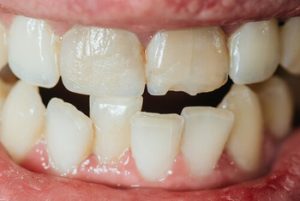Crooked teeth are more common than many people think, and they can affect more than just the way your smile looks. From functional challenges like difficulty chewing and cleaning teeth, to emotional impacts such as feeling self-conscious in social settings, misaligned teeth can have far-reaching consequences on oral health and overall well-being.
But what causes crooked teeth in the first place? The answer is not always straightforward. A mix of genetics, habits, environmental factors, and even facial injuries can play a role in shaping your bite. In this article, we’ll unpack the various causes of crooked teeth, explain how they affect dental health, and explore ways to straighten crooked teeth through modern orthodontic treatment options.
Genetics and Hereditary Factors
 One of the most significant contributors to crooked teeth is genetics. Just as we inherit our eye colour or height, we also inherit jaw shape, jaw size, and tooth alignment from our parents. If one or both parents had misaligned teeth or bite problems, there’s a strong chance the child may experience the same.
One of the most significant contributors to crooked teeth is genetics. Just as we inherit our eye colour or height, we also inherit jaw shape, jaw size, and tooth alignment from our parents. If one or both parents had misaligned teeth or bite problems, there’s a strong chance the child may experience the same.
Some people are born with narrow jaws, which leads to crowding as there simply isn’t enough room for the permanent teeth to grow into the proper position. Others may have extra teeth, missing teeth, or oddly shaped teeth that can throw off alignment. These hereditary factors often influence how the upper and lower jaws develop and whether the teeth fit together well.
Childhood Habits That Lead to Misalignment
Many issues with crooked teeth can be traced back to habits during early childhood when both baby teeth and jaw growth are still developing.
- Thumb sucking: While it’s a natural soothing mechanism for babies, persistent thumb sucking beyond the age of 3 or 4 can cause the upper front teeth to protrude. This habit may also lead to an open bite or affect the alignment of the upper jaw and lower jaw.
- Tongue thrusting: When a child pushes their tongue against the front teeth during swallowing or speaking, it can gradually push the front teeth forward, leading to speech difficulties or bite issues.
- Prolonged dummy use or bottle-feeding: Much like thumb sucking, extended use of pacifiers or bottles can impact tooth alignment and jaw shape if not stopped at the appropriate developmental stage.
These behaviours don’t just influence baby teeth. Because the position of baby teeth helps guide the eruption of permanent teeth, any misalignment early on can contribute to more serious issues later.
Dental Issues and Poor Oral Habits
In some cases, crooked or misaligned teeth result from problems that develop over time. These may be related to poor dental care, missing teeth, or untreated oral health issues.
- Tooth decay and gum disease: Severe tooth decay, especially in children, may result in early loss of baby teeth. When this happens, other teeth may shift into the empty space, preventing the proper eruption of the permanent tooth underneath. Gum disease can similarly cause teeth to loosen and shift.
- Tooth loss: When a permanent tooth is lost due to trauma, decay, or disease, and not replaced, the surrounding teeth can begin to drift out of position. Over time, this creates gaps, crowding, and misalignment.
- Poor dental care: Neglecting oral hygiene can contribute to cavities, gum disease, and the premature loss of both baby and permanent teeth. Without timely intervention, tooth alignment may be permanently affected.
Environmental and Physical Influences
Outside of genetics and habits, certain environmental factors and physical traumas also play a role.
- Facial injury: A blow to the mouth or jaw, such as from a fall, car accident, or sporting injury, can knock teeth out of position or even damage jaw growth during childhood. This may cause the upper or lower jaws to develop abnormally, leading to crooked teeth or bite problems.
- Less chewing: Some research suggests that modern diets, which often consist of soft and processed foods, require less chewing. Reduced use of the jaw muscles may impact jaw development, potentially contributing to narrow jaws and misalignment over time.
Developmental Factors and Jaw Growth
The relationship between the upper jaw and lower jaw is complex, and even small differences in jaw size or alignment can impact how teeth erupt and settle into place.
If the upper molars or lower molars don’t meet properly, it can result in an uneven bite, also known as a malocclusion. This often becomes apparent when the permanent teeth begin to erupt. A mismatch in jaw size may cause crowding, gaps, or one set of teeth (usually the lower teeth) to push against the other.
The rate and direction of jaw growth during puberty can also affect how straight teeth remain during adolescence and into adulthood. Left untreated, bite problems caused by uneven jaw growth can worsen over time, leading to both functional and aesthetic challenges.
How Crooked Teeth Affect Oral and Overall Health
Crooked or misaligned teeth aren’t just a cosmetic concern. They can lead to a range of dental health issues, including:
- Difficulty cleaning: Crowded or overlapping teeth can make brushing and flossing difficult, increasing the risk of plaque buildup and decay.
- Tooth wear and damage: Uneven bite forces can cause abnormal wear on certain teeth, increasing the chance of chipping or fractures.
- Jaw strain and discomfort: Bite problems may put stress on the jaw muscles and joints, leading to headaches, jaw pain, or even temporomandibular joint (TMJ) dysfunction.
- Speech difficulties: Severe misalignment can interfere with tongue movement and cause speech issues, especially if the upper or lower front teeth protrude significantly.
On a psychological level, people with visibly crooked teeth may feel self-conscious about their smile, which can affect confidence and social interaction.
Straightening Teeth: What Are Your Options?
Fortunately, there are several modern ways to straighten crooked teeth and improve both appearance and function. The right solution is based on how severe the misalignment is, the individual’s age, and their general oral condition.
1. Traditional Metal Braces
With metal brackets and wires, traditional braces slowly reposition teeth into the correct alignment. They work well in managing complex situations such as overcrowding, gaps, and bite irregularities. While not the most discreet option, they are reliable and widely used by dental professionals across Australia.
 2. Clear Aligners
2. Clear Aligners
Clear plastic aligners have become a popular alternative to metal braces, particularly for adults. These removable trays are virtually invisible and can correct many types of misalignment, especially mild to moderate cases. However, they may not be suitable for more severe alignment issues.
3. Lingual Braces
Lingual braces work like traditional braces but are fitted behind the teeth, allowing for a more discreet appearance. They’re an option for those who want the benefits of metal braces without affecting their physical appearance as much.
When Should You See a Dental Professional?
If your teeth are slightly crooked or you notice early signs of misalignment in your child’s smile, it’s best to consult a dental professional. Addressing alignment issues early on can help avoid more complicated concerns in the future. Orthodontics isn’t purely about appearance; it also helps restore function, improve jaw alignment, and maintain dental health over time. Whether it’s you or your child who requires braces, aligners, or another type of orthodontic care, early action often leads to better outcomes.
Final Thoughts: The Value of Straight Teeth
Crooked teeth are the result of a variety of interconnected causes, ranging from hereditary traits and poor oral habits to environmental influences and untreated dental issues. If not treated, misaligned teeth may result in bite issues, dental decay, gum infection, and eventual tooth loss, along with issues related to self-confidence.
If you’re concerned about crooked teeth or want to enjoy the confidence of a straight, healthy smile, book a consultation with us at Maroondah Dental Care or call 03 9007 2532. We’ll take the time to walk you through your available options and recommend a treatment path that aligns with your needs and comfort.
Resources
Whelan, C. (2019). ‘What Causes Crooked Teeth and How to Straighten Them’. Healthline, 8 May. San Francisco, CA: Healthline Media. https://www.healthline.com/health/dental-and-oral-health/crooked-teeth
Watson, S. (2024). ‘Gingivitis and Periodontal Disease (Gum Disease)’. WebMD, 9 February. Atlanta, GA: WebMD LLC. https://www.webmd.com/oral-health/gingivitis-periodontal-disease
NHS (2023). ‘Orthodontic Treatments’. NHS, 3 April. London, UK: National Health Service. https://www.nhs.uk/tests-and-treatments/orthodontics/treatments/


 2. Clear Aligners
2. Clear Aligners
